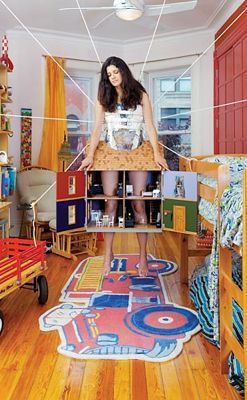This week’s column features a new interview with Janine Antoni in advance of her upcoming keynote address and workshop at the National Art Education Association’s annual conference on March 2nd here in New York City.
As many of you already know, Antoni’s work blurs the distinction between performance art and sculpture. Using her body, she transforms everyday activities such as eating, bathing, and sleeping into ways of making art. She has chiseled cubes of lard and chocolate with her teeth, washed away the faces of soap busts made in her own likeness, and used the brainwave signals recorded while she dreamed at night as a pattern for weaving a blanket the following morning.
The second half of my interview with Janine will post next week. For links to both parts of our conversation from 2009 click here: part one & part two.
Enjoy!
Tell me about some of the things you have been focusing on at Columbia University since the last time we spoke. What course(s) are you teaching and what has the experience been like?
Janine Antoni: I’ve been teaching for the graduate program at Columbia University over the past 12 years in a very interesting program they’ve developed called the Master Class/ Mentor Groups. The students chose two mentors from a pool of twelve artists from very different perspectives. It is a one-week workshop that happens every semester during their two years of graduate school. There is an intensity created from being together all day that leads to a kind of intimacy that’s very productive to teaching. Columbia has never instructed me on what to teach but the intention of the class is for the students to get into the mind of their chosen artist, allowing them to experience one way of being an artist in the world. This enables me to model the class alongside my current creative process and explorations. Over the years, after a lot of experimentation, I’ve slowly developed a methodology that seems to foster creativity in interesting ways. I create a loose theme for the week, and I vary the activities as much as possible. We make, we look, we move, we explore, we create dialog, and I intentionally create gaps between these approaches and the theme is never revealed. These gaps are created to allow the artists to find bridges in relationship to their work and interests. Again and again I am surprised at how their experience during mentor week triggers new work. The thing that I’m interested in is that the creative process is never in a straight line, so if you teach in a straight line you won’t get the best results. To create you have to be out on a limb and to teach requires the same risk.
Since you have a child in school now, I am wondering about your reactions to the art making experiences she has had so far. What kinds of things has she described when it comes to participating in “art class”?
JA: She rarely speaks about her art classes specifically. But the other day she told me that she’s the only one in her class that can cut a perfect circle. She wasn’t so interested in the fact that she perfected this craft but what she wanted me to know is that she could make a perfect circle as a lefty using a righty scissor. She instinctively invents a personal way of approaching all tasks. What’s important for me is that I value that personal approach in her and that her teachers have the sensitivity to do that as well.
I often witness the effects of her growing up with artist parents. Her father Paul Ramirez Jonas is also an artist. In our studio he has created a little loft space that is entirely her own creative hideaway. She would come into the studio and the first thing she would say is, “Can I see chocolate mommy?” Her presence in the studio has made her comfortable enough to offer up her ideas for new work. The other day she mentioned she would like to make a performance where she massages people with Jell-O. Only because she’s grown up around contemporary artists does she think this is possible.
Next week you will have about three thousand art educators from all over the country listening to your keynote address at the National Art Education Association’s annual conference. What do you most look forward to about participating in this year’s conference and what made you originally want to participate?
JA: I want people to love art and appreciate the richness it can provide for one’s life. I see teachers as our first initiators. This introduction can set the stage for what a relationship with art can be. One does not need to be an artist to have one’s life enriched by art. Art provides an alternative way of learning that could be valuable in all aspects of our lives. Although I am far from a trained teacher of art, I feel that looking at an artist’s creative process can give clues about how to approach teaching art.
Visit the column on Art21’s blog next week for part two of our conversation… See you then.






Pingback: Talking with Janine Antoni and Getting Set for NAEA: Part Two | Art21 Blog
Pingback: Five Years of Teaching with Contemporary Art | Art21 Blog